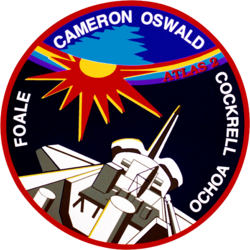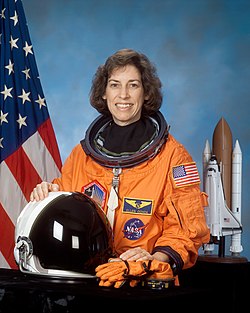Ellen Ochoa
| Ellen Lauri Ochoa | |
 | |
| NASA-astronaut | |
|---|---|
| Född | 10 maj 1958 Los Angeles, Kalifornien |
| Tid i rymden | 40 dagar, 19 timmar, 36 minuter |
| Urvalsgrupp | Astronautgrupp 13 |
| Uppdrag | STS-56, STS-66, STS-96, STS-110 |
| Uppdragsemblem | |
Ellen Ochoa, född 10 maj 1958 i Los Angeles, är en amerikansk astronaut uttagen i astronautgrupp 13 den 17 januari 1990.
2007 blev hon vicedirektör för NASAs Johnson Space Center och sedan 1 januari 2013 är hon direktör för Johnson Space Center.
Rymdfärder
Referenser
”Biographical Data” (på engelska) (PDF). NASA. maj 2018. https://www.nasa.gov/wp-content/uploads/2017/05/ochoa.pdf?emrc=07a2c2. Läst 3 maj 2024.
|
Media som används på denna webbplats
Emblem of Nasa's STS-110 mission.
- The STS-110 mission begins the third and final phase of construction for the International Space Station (ISS) by delivering and installing the SØ truss segment that will be carried into orbit in the payload bay of the Space Shuttle Atlantis. The Station’s robotic arm will remove the SØ segment from the Shuttle’s payload bay and place it on top of the United States Laboratory. During several space walks, SØ will be mechanically attached to ISS, and then multiple cables will be connected allowing electrical power and communications to flow between SØ and ISS. The STS-110 crew patch is patterned after the cross section of the SØ truss, and encases the launch of the Shuttle Atlantis and a silhouette of the ISS as it will look following mission completion. The successfully installed SØ segment is highlighted in gold. The SØ truss will serve as the cornerstone for the remaining ISS truss segments which together will span a distance greater than the length of a football field. This truss holds the Station’s massive solar arrays, providing electrical power for the modules of all the International Partners, and enables ISS to reach its full potential as a world-class research facility.
STS-66 Mission Insignia
STS-56 Mission Insignia
Designed by the crew members, this is the mission insignia for the STS-96 space flight, the second Space Shuttle mission dedicated to the assembly of the International Space Station (ISS). The crew patch highlights the major themes of the Station Program: Earth-directed research, the advancement of human space exploration, and international cooperation. The Space Shuttle Discovery is depicted shortly after reaching orbit as the crew prepares to carry out the first docking with the new Station. At this early stage in its construction, ISS consists of two modules: Zarya and Unity, shown orbiting Earth. The triangular shape of the patch represents building on the knowledge and experience of earlier missions, while the three vertical bars of the astronaut emblem point toward future human endeavors in space. The five-pointed star that tops the astronaut emblem in this depiction is symbolic of the five space agencies participating in the development of ISS: NASA, the Russian Space Agency, the European Space Agency, the National Space Development Agency of Japan, and the Canadian Space Agency. The blend of red, white, and blue is a tribute to the nationalities of the crew members who are from the United States, Canada, and Russia.





